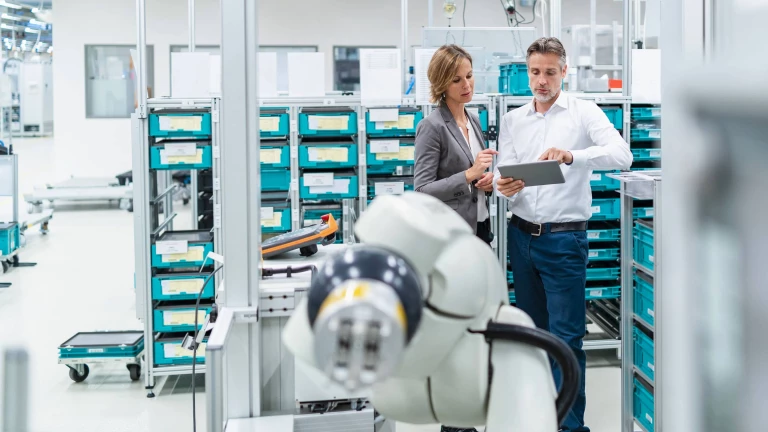BCG at AWS re:Invent 2023
Technology is evolving at breakneck speed. As a strategic alliance partner to AWS, BCG is looking forward to discuss tomorrow's potential at re:Invent 2023, taking place November 27–December 1 in Las Vegas, Nevada.

The new wave of generative AI systems, such as ChatGPT, have the potential to transform entire industries. To be an industry leader in five years, you need a clear and compelling generative AI strategy today.
We are entering a period of generational change inartificial intelligence. Until now, machines have never been able to exhibit behavior indistinguishable from humans. But new generative AI models are not only capable of carrying on sophisticated conversations with users; they also generate seemingly original content.
To gain a competitive edge, business leaders first need to understand what generative AI is.
Generative AI is a set of algorithms, capable of generating seemingly new, realistic content—such as text, images, or audio—from the training data. The most powerful generative AI algorithms are built on top of foundation models that are trained on a vast quantity of unlabeled data in a self-supervised way to identify underlying patterns for a wide range of tasks.
For example, GPT-3.5, a foundation model trained on large volumes of text, can be adapted for answering questions, text summarization, or sentiment analysis. DALL-E, a multimodal (text-to-image) foundation model, can be adapted to create images, expand images beyond their original size, or create variations of existing paintings.
These new types of generative AI have the potential to significantly accelerate AI adoption, even in organizations lacking deep AI or data-science expertise. While significant customization still requires expertise, adopting a generative model for a specific task can be accomplished with relatively low quantities of data or examples through APIs or by prompt engineering. The capabilities that generative AI supports can be summarized into three categories:
Today, some generative AI models have been trained on large of amounts of data found on the internet, including copyrighted materials. For this reason,responsible AIpractices have become an organizational imperative.

Generative AI systems are democratizing AI capabilities that were previously inaccessible due to the lack of training data and computing power required to make them work in each organization’s context. The wider adoption of AI is a good thing, but it can become problematic when organizations don’t have appropriate governance structures in place.
Generative AI text models can be used to generate texts based on natural language instructions, including but not limited to:
This is just the beginning. As companies, employees, and customers become more familiar with applications based on AI technology, and as generative AI models become more capable and versatile, we will see a whole new level of applications emerge.
Technology is evolving at breakneck speed. As a strategic alliance partner to AWS, BCG is looking forward to discuss tomorrow's potential at re:Invent 2023, taking place November 27–December 1 in Las Vegas, Nevada.
BCG’s delegation of experts will be at CES 2024 in Las Vegas from January 9–12, to engage on breakthrough technologies and innovations. Learn more about our programming and arrange a meeting with the team.
Generative AI has massive implications for business leaders—and many companies have already gone live with generative AI initiatives. In some cases, companies are developing custom generative AI model applications by fine-tuning them with proprietary data.
The benefits businesses can realize utilizing generative AI include:

Gaining competitive advantage from generative AI will demand far-reaching redesigns of organizations and human resources. BCG’s Allison Bailey explains.
Explore the full video series on YouTube
Generative AI technology will cause a profound disruption to industries and may ultimately aid in solving some of the most complex problems facing the world today. Three industries have the highest potential for growth in the near term: consumer, finance, and health care.
Given that the pace the technology is advancing, business leaders in every industry should consider generative AI ready to be built into production systems within the next year—meaning the time to start internal innovation is right now. Companies that don’t embrace the disruptive power of generative AI will find themselves at an enormous—and potentially insurmountable—cost and innovation disadvantage.
BCG is collaborating with OpenAI to help our clients realize the power of OpenAI technologies and solve the most complex challenges using generative AI—responsibly.
BCG and Google Cloud are excited about generative AI’s transformative capabilities, devoting significant resources to jointly help customers apply this breakthrough technology.
The ability to scale AI applications continues to challenge businesses across industries. Our collaboration with Intel brings together BCG’s transformation expertise, BCG X’s engineering capabilities, and Intel’s AI hardware and software in order to rapidly create enterprise-grade generative AI solutions for our clients—securely and responsibly.

The company’s leaders recognize that a GenAI transformation requires a transformation of business processes and people development.

Generative AI presents both benefits and challenges to organizations. BCG’s GenAI Workforce Productivity Diagnostic helps companies define a clear path to successfully implement this transformative technology.

Despite the generative AI hype, more than 50% of executives are deeply worried about incorporating it into their operations.
A first-of-its-kind scientific experiment finds that people mistrust generative AI in areas where it can contribute massive value and trust it too much where the technology isn’t competent.
的断言age half-life of skills now less than five years—and half that in some tech fields—organizations need a new approach to reskilling their workforce.
The latest technologies hold tremendous promise for health care, but they also pose significant challenges. Not all organizations are prepared to take advantage of the tech trends.
BCG’s generative AI experts have deep experience in AI technology, neural networks, generative models, the benefits of generative AI, and more. Here are some of our experts in generative AI.